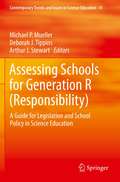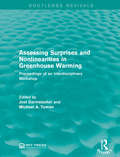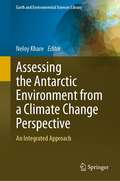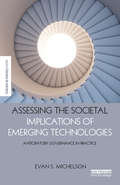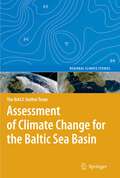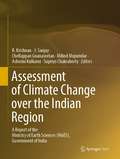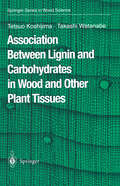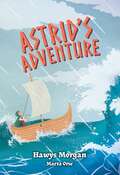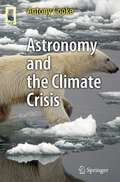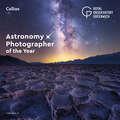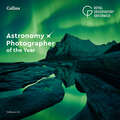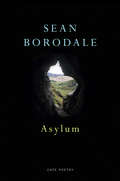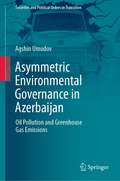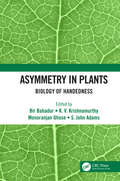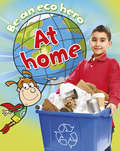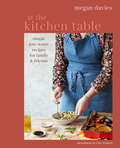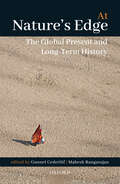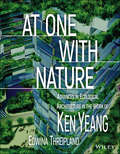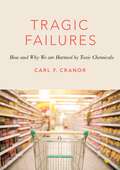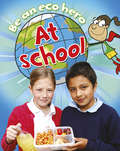- Table View
- List View
Assessing Schools for Generation R: A Guide for Legislation and School Policy in Science Education (Contemporary Trends and Issues in Science Education #41)
by Michael P. Mueller Deborah J. Tippins Arthur J. StewartToday’s youth will face global environmental changes, as well as complex personal and social challenges. To address these issues this collection of essays provides vital insights on how science education can be designed to better engage students and help them solve important problems in the world around them.Assessing Schools for Generation R (Responsibility) includes theories, research, and practices for envisioning how science and environmental education can promote personal, social, and civic responsibility. It brings together inspiring stories, creative practices, and theoretical work to make the case that science education can be reformed so that students learn to meaningfully apply the concepts they learn in science classes across America and grow into civically engaged citizens. The book calls for a curriculum that equips students with the knowledge, skills, attitudes and values to confront the complex and often ill-defined socioscientific issues of daily life.The authors are all experienced educators and top experts in the fields of science and environmental education, ecology, experiential education, educational philosophy, policy and history. They examine what has to happen in the domains of teacher preparation and public education to effect a transition of the youth of America. This exciting, informative, sophisticated and sometimes provocative book will stimulate much debate about the future direction of science education in America, and the rest of the world. It is ideal reading for all school superintendents, deans, faculty, and policymakers looking for a way to implement a curriculum that helps builds students into responsible and engaged citizens.
Assessing Surprises and Nonlinearities in Greenhouse Warming: Proceedings of an Interdisciplinary Workshop (Routledge Revivals)
by Joel Darmstadter Michael A. TomanIn 1992, Resources for the Future conducted a workshop concerning the issues of global climate change. This title, originally published in 1993, is a collection of the revised versions of the papers commissioned for the workshop with an added introduction and overview. Each paper emphasises the potential nonlinearities or surprises in physical effects caused by humans loading the atmosphere with greenhouse gases and examines how shifts in the natural environment from climate change may affect human well-being. This collection is a valuable resource for any student interested in environmental studies and climate change issues.
Assessing Surprises and Nonlinearities in Greenhouse Warming: Proceedings of an Interdisciplinary Workshop (Routledge Revivals)
by Joel Darmstadter Michael A. TomanIn 1992, Resources for the Future conducted a workshop concerning the issues of global climate change. This title, originally published in 1993, is a collection of the revised versions of the papers commissioned for the workshop with an added introduction and overview. Each paper emphasises the potential nonlinearities or surprises in physical effects caused by humans loading the atmosphere with greenhouse gases and examines how shifts in the natural environment from climate change may affect human well-being. This collection is a valuable resource for any student interested in environmental studies and climate change issues.
Assessing the Antarctic Environment from a Climate Change Perspective: An Integrated Approach (Earth and Environmental Sciences Library)
by Neloy KhareThe present book covers diversified contributions addressing the impact of climate change on the Antarctic environment. It covers the reconstruction of environmental changes using different proxies. The chapters focus on the glacial history, glacial geomorphology, sedimentology, and geochemistry of Antarctic region. Furthermore, the Cenozoic evolution of the Antarctic ice sheet is discussed along with a Scientometrics analysis of climate change research. The book serves as a useful reference for researchers who are fascinated by the polar region and environmental research.
Assessing the Societal Implications of Emerging Technologies: Anticipatory governance in practice (The Earthscan Science in Society Series)
by Evan S. MichelsonA growing problem of interest in the field of science and technology policy is that the next generation of innovations is arriving at an accelerating rate, and the governance system is struggling to catch up. Current approaches and institutions for effective technology assessment are ill suited and poorly designed to proactively address the multidimensional, interconnected societal impacts of science and technology advancements that are already taking place and expected to continue over the course of the 21st century. This book offers tangible insights into the strategies deployed by well-known, high-profile organizations involved in anticipating the various societal and policy implications of nanotechnology and synthetic biology. It focuses predominantly on an examination of the practices adopted by the often-cited and uniquely positioned Project on Emerging Nanotechnologies in the United States, as well as being informed by comparisons with a range of institutions also interested in embedding forward-looking perspectives in their respective area of innovation. The book lays out one of the first actionable roadmaps that other interested stakeholders can follow when working toward institutionalizing anticipatory governance practices throughout the policymaking process.
Assessing the Societal Implications of Emerging Technologies: Anticipatory governance in practice (The Earthscan Science in Society Series)
by Evan S. MichelsonA growing problem of interest in the field of science and technology policy is that the next generation of innovations is arriving at an accelerating rate, and the governance system is struggling to catch up. Current approaches and institutions for effective technology assessment are ill suited and poorly designed to proactively address the multidimensional, interconnected societal impacts of science and technology advancements that are already taking place and expected to continue over the course of the 21st century. This book offers tangible insights into the strategies deployed by well-known, high-profile organizations involved in anticipating the various societal and policy implications of nanotechnology and synthetic biology. It focuses predominantly on an examination of the practices adopted by the often-cited and uniquely positioned Project on Emerging Nanotechnologies in the United States, as well as being informed by comparisons with a range of institutions also interested in embedding forward-looking perspectives in their respective area of innovation. The book lays out one of the first actionable roadmaps that other interested stakeholders can follow when working toward institutionalizing anticipatory governance practices throughout the policymaking process.
Assessment of Climate Change for the Baltic Sea Basin (Regional Climate Studies)
by BACC Author TeamThis book offers an up-to-date overview of the latest scientific findings in regional climate research on the Baltic Sea basin. This includes climate changes in the recent past, climate projections up until 2100 using the most sophisticated regional climate models available, and an assessment of climate change impacts on terrestrial, freshwater and marine ecosystems. The authors demonstrate that the regional climate has already started to change, and will continue to do so.
Assessment of Climate Change over the Indian Region: A Report of the Ministry of Earth Sciences (MoES), Government of India
by R. Krishnan J. Sanjay Chellappan Gnanaseelan Milind Mujumdar Ashwini Kulkarni Supriyo ChakrabortyThis open access book discusses the impact of human-induced global climate change on the regional climate and monsoons of the Indian subcontinent, adjoining Indian Ocean and the Himalayas. It documents the regional climate change projections based on the climate models used in the IPCC Fifth Assessment Report (AR5) and climate change modeling studies using the IITM Earth System Model (ESM) and CORDEX South Asia datasets. The IPCC assessment reports, published every 6–7 years, constitute important reference materials for major policy decisions on climate change, adaptation, and mitigation. While the IPCC assessment reports largely provide a global perspective on climate change, the focus on regional climate change aspects is considerably limited. The effects of climate change over the Indian subcontinent involve complex physical processes on different space and time scales, especially given that the mean climate of this region is generally shaped by the Indian monsoon and the unique high-elevation geographical features such as the Himalayas, the Western Ghats, the Tibetan Plateau and the adjoining Indian Ocean, Arabian Sea, and Bay of Bengal. This book also presents policy relevant information based on robust scientific analysis and assessments of the observed and projected future climate change over the Indian region.
Association Between Lignin and Carbohydrates in Wood and Other Plant Tissues (Springer Series in Wood Science)
by Tetsuo Koshijima Takashi WatanabeAstronomy and the Climate Crisis (Astronomers' Universe)
by Antony CookeClimate change is acknowledged as being one of the most important areas of research today. Increasing global temperatures will impact all of us to a greater or lesser extent. From the point of view of research it is an enormously important and complex subject. However, little attention is paid to its relationship to astronomy, the sun in particular but not exclusively. Though directed at an astronomically inclined readership, and providing some less well-known astronomically related information, studies and concepts, this book will also appeal to a broader public, who need to understand the subject of climate change and learn of all the various theories and possible solutions.
Astronomy Photographer of the Year: Collection 11
by Royal Observatory Greenwich Collins AstronomyA stunning ebook with clear navigation for admirers of astrophotography. This ebook has been built to W3C accessibility guidelines and will work with text to speech. The layout has been redesigned with clear navigation links to each of the competition entries within the Maps section. It is compatible with all ereading apps and devices.
Astronomy Photographer of the Year: Collection 12
by Royal Observatory Greenwich Collins AstronomyA stunning ebook with clear navigation for admirers of astrophotography. This ebook has been built to W3C accessibility guidelines and will work with text to speech. The layout has been redesigned with clear navigation links to each of the competition entries within the Maps section. It is compatible with all ereading apps and devices.
Asylum
by Sean BorodaleLike his two previous books, Asylum was written live on-site; in this case deep within the caves, mines, quarries, geological and archaeological horizons of the Mendip Hills in Somerset. The poems stage modes of exile in the darkness of earth, enacting solidarity with those others who have made their journey into the underworld – Dante, Orpheus, blinded Oedipus, Euripides. These are semi-dramatic voicings, staged across the thirty-mile theatre of the Mendip subterranean: each an act of recovery, of rescue. Traversing the broken, collapsed, eroded stones, looking for voices that express the damaged and the damned, Asylum pays homage to the darkness of the human cave: its memories and ancient histories, and to its more contemporary signals – internationally owned quarries, abandoned coal mines, decommissioned Cold War bunkers.As with Bee Journal and Human Work, these poems take on the nature of the experience recorded. Written blind, as it were, the diction here becomes mineral, deeply tactile – hard and granular, alert to sound in its own blackness. Descending underground with the poet is to enter a theatre of heightened senses, and these extraordinary poems feel both unearthed and unearthly.
Asymmetric Environmental Governance in Azerbaijan: Oil Pollution and Greenhouse Gas Emissions (Societies and Political Orders in Transition)
by Agshin UmudovThis book examines why authoritarian governments are willing to address environmental problems that have an international impact, such as CO2 emissions, but are reluctant to address problems that have only a domestic impact. In a case study of Azerbaijani oil politics, it demonstrates how the incumbent Azerbaijani regime has taken important measures trying to address CO2 emissions while ignoring the damage caused by oil pollution on the Caspian coast. The book argues that resource-rich authoritarian governments are eager to join international environmental initiatives to improve their image, but they address domestic environmental issues mainly if they threaten their hold on power.This book is an important contribution to scholarship on environmental governance in the post-Soviet space, an area that is poorly researched. Therefore, it is a must-read for researchers and scholars interested in post-Soviet studies, as well as in the nexus between mineral-rich regions and how social policy is created, e.g., environment, education, and healthcare. In addition, this book will be of tremendous importance for policymakers and international organizations as it looks into the motivation of authoritarian states in the post-Soviet space for environmental measures.
Asymmetry in Plants: Biology of Handedness
by Bir Bahadur K. V. Krishnamurthy Manoranjan Ghose S. John AdamsPlants exhibit forms of asymmetry analogous to "handedness" in bilaterally symmetrical animals. This book explores the evolutionary significance and development of asymmetry. Examples of genetic control include the direction of tendril or stem coiling of many climbing plants; the so-called spiral phyllotaxy and floral taxy; and contorted petal arrangement is another kind of left- right symmetry in plants; the direction of contortion is fixed in some but not in other plants. The book will underscore tha all phenomena related to handedness start during embryogenesis itself, with the occurrence of embryo rotation. Key selling features: First consolidated book on Plant Handedness Relates handedness, asymmetry and chirality to the evolution of different organizational levels in plant biology Emphasizes handedness as a vital governing force in plant functional evolution Provides a new perspective, hitherto ignored, into plant developemtn and evolution Describes how an age-old phenomenon can give scope for investigation from a very modern interdisciplinary approach
Asymmetry in Plants: Biology of Handedness
by Bir Bahadur K. V. Krishnamurthy Monoranjan Ghose S. John AdamsPlants exhibit forms of asymmetry analogous to "handedness" in bilaterally symmetrical animals. This book explores the evolutionary significance and development of asymmetry. Examples of genetic control include the direction of tendril or stem coiling of many climbing plants; the so-called spiral phyllotaxy and floral taxy; and contorted petal arrangement is another kind of left- right symmetry in plants; the direction of contortion is fixed in some but not in other plants. The book will underscore tha all phenomena related to handedness start during embryogenesis itself, with the occurrence of embryo rotation. Key selling features: First consolidated book on Plant Handedness Relates handedness, asymmetry and chirality to the evolution of different organizational levels in plant biology Emphasizes handedness as a vital governing force in plant functional evolution Provides a new perspective, hitherto ignored, into plant developemtn and evolution Describes how an age-old phenomenon can give scope for investigation from a very modern interdisciplinary approach
At Home (Be an Eco Hero #1)
by Susan BarracloughFind out how you can be an eco hero at home! Learn how to save energy and water, and how to reduce, reuse and recycle your waste. This colourful book for children features large photographs and engaging superhero children characters that are illustrated in a cartoon style.
At The Kitchen Table: Simple, low-waste recipes for family and friends
by Megan DaviesWant to eat well, reduce food and packaging waste and save some money? Home Bird is here to help, going back to basics with seasonal, bold and wholesome recipes that are not only better for the environment but also your well-being and budget.Influenced by nostalgic meals and cooking for loved ones, Megan Davies has written this book for the eco-minded home cook. She includes invaluable tips on how to make ingredients stretch; from potato peel crisps to pickled cucumber and beetroot. Megan also features ways to turn leftovers into a new meal, such as a Roasted Fennel, Chive and Dill Pasta Bake or Frittata, both from a leftover Raw Fennel, Chive and Dill Salad. Recipes include multi-tasking brunch or late-night dishes such as Bircher Pancakes or Sweet Potato Baked Eggs. Suppers for Sharing that can be scaled up to feed a crowd or down for a more intimate occasion range from Roasted Squash with Almonds and Tarragon to the best Roast Chicken recipe with Pan Pastry Croutons (plus, of course, ways to use up any uneaten chicken!). From On the Side accompaniments and stunning Sweet Things such as Pot Luck Tarte Tatin this collection of delicious and ingenious recipes will have all the inspiration you need to run a more sustainable home kitchen, reduce your carbon footprint and make the sort of small changes at home that can make a big difference to our world.
At Nature’s Edge: The Global Present and Long-Term History
by Gunnel Cederlöf Mahesh RangarajanIn an epoch when environmental issues make the headlines, this is a work that goes beyond the everyday. Ecologies as diverse as the Himalayas and the Indian Ocean coast, the Negev desert and the former military bases of Vietnam, or the Namib desert and the east African savannah all have in common a long-time human presence and the many ways people have modified nature. With research covering countries from Asia, Africa, and Australia, the authors come together to ask how and why human impacts on nature have grown in scale and pace from a long pre-history. The chapters in this volume illumine specific patterns and responses across time, going beyond an overt centring of the European experience. The tapestry of life and the human reshaping of environments evoke both concern and hope, making it vital to understand when, why, and how we came to this particular turn in the road. Eschewing easy labels and questioning eurocentrism in today’s climate vocabulary, this is a volume that will stimulate rethinking among scholars and citizens alike.
At One with Nature: Advances in Ecological Architecture in the Work of Ken Yeang
by Ken Yeang Edwina Threipland"At One with Nature is an inspiring collection of the latest work of Ken Yeang that further advances sustainable architecture and design. This collection features recent projects as he explores how we can achieve harmony between the natural and our built environments to create a better planet by design. Each project features and highlights not only the systems and devices adopted, but also outlines the intentions and ecological considerations demonstrating best practices for how we can proceed moving forward. The book role models our living Earth and shows how we can behave as stewards of our planet."--Cassia Patel, Oceanic Global Foundation At One with Nature showcases Ken Yeang's latest ideas, built projects designs, research work and advances in the field of designing with nature, a topic that Yeang has pioneered and developed over many decades since receiving his doctorate in ecological design and planning from Cambridge University. His ideas and work are even more pertinent today with the current state of devastation of Earth's natural systems and a biogeochemical cycle that has been extensively and severely impacted by human society. The global environment today is in a state of crisis, but what can society do to address the issues? Yeang's recent projects are presented with instructive diagrams that provide a basis for action for architects, planners, designers, engineers, and anyone whose daily work impinges on the natural environment. Offered in a highly visual, annotated format, with instructive illustrations of Yeang's theoretical books on the topic, At One with Nature is an invaluable resource that students and academics interested in designing with nature will find both informative and relevant.
AT RISK TRL C: How and Why We are Harmed by Toxic Chemicals (The Romanell Lectures)
by Carl F. CranorThe world is awash in chemicals created by fellow citizens, but we know little to nothing about them. Understanding whether even the most prevalent ones are toxic would take decades. Many people have tragically suffered serious diseases and premature death, including children during development. Why has this occurred? Many factors contribute, but two important ones are the laws permitting this and the manner in which science has been used to identify and assess whether or not products are toxic. Both are the outcome of legislative, corporate, and judicial choices. Congress created laws that in fact keep public health officials and the wider population in the dark about the toxicity of virtually all substances other than prescription drugs and pesticides. Facing considerable ignorance about toxic substances, impartially motivated scientists seeking to protect the public health are constrained by the natural pace of studies to reveal toxic effects. Corporate pressures on public health officials and scientific obstruction substantially heighten the barriers to protecting the public. When people have suffered serious as well as life-threatening diseases likely traceable to toxic substances, judicial errors barring relevant science in the personal injury (tort) law can and have frustrated redress of injustices. Under both public health law and the tort law, there are possibilities for improved approaches, provided public leaders make different and better choices. This book describes these issues and suggests how we could be better protected from myriad toxic substances in our midst.
At School (Be an Eco Hero #2)
by Susan BarracloughFind out how you can be an eco hero at school! Learn about the best ways to travel to school and cut down on your energy and water use while you are there. This colourful book for children features large photographs and engaging superhero children characters that are illustrated in a cartoon style.
At the Heart of the Coral Triangle: Celebrating Biodiversity
by Alan J Powderham Sancia van der Meij"Endlessly fascinating, unpretentiously educational, thoughtfully accessible and beautifully presented" - Alex Tattersall, award-winning underwater photographer and the founder of Underwater Visions. The Coral Triangle, straddling the confluence of the Indian and Pacific Oceans, harbours the greatest biodiversity of marine life on the planet. It is home to a wondrous variety, including 75% of the world's coral species and around 2500 species of fish. The biological and environmental diversity is driven by the volcanically active and complex geology of the so called 'Ring of Fire'. Habitats range from underwater slopes of volcanic black sand to extensive coral reefs in atolls and vast calderas. While clearly vulnerable to increasing global threats such as climate change, pollution and overfishing, the Coral Triangle currently features some the richest coral reefs in the world. With stunning photography supported by an engaging and accessible text, this book highlights and celebrates this biodiversity along with the underlying message that it needs our care and protection before it is too late.
At the Heart of the Coral Triangle: Celebrating Biodiversity
by Alan J Powderham Sancia van der Meij"Endlessly fascinating, unpretentiously educational, thoughtfully accessible and beautifully presented" - Alex Tattersall, award-winning underwater photographer and the founder of Underwater Visions. The Coral Triangle, straddling the confluence of the Indian and Pacific Oceans, harbours the greatest biodiversity of marine life on the planet. It is home to a wondrous variety, including 75% of the world's coral species and around 2500 species of fish. The biological and environmental diversity is driven by the volcanically active and complex geology of the so called 'Ring of Fire'. Habitats range from underwater slopes of volcanic black sand to extensive coral reefs in atolls and vast calderas. While clearly vulnerable to increasing global threats such as climate change, pollution and overfishing, the Coral Triangle currently features some the richest coral reefs in the world. With stunning photography supported by an engaging and accessible text, this book highlights and celebrates this biodiversity along with the underlying message that it needs our care and protection before it is too late.
